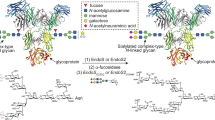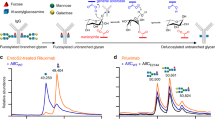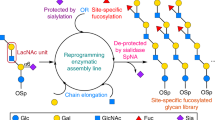Abstract
Mammalian cell surface and secreted glycoproteins exhibit remarkable glycan structural diversity that contributes to numerous physiological and pathogenic interactions. Terminal glycan structures include Lewis antigens synthesized by a collection of α1,3/4-fucosyltransferases (CAZy GT10 family). At present, the only available crystallographic structure of a GT10 member is that of the Helicobacter pylori α1,3-fucosyltransferase, but mammalian GT10 fucosyltransferases are distinct in sequence and substrate specificity compared with the bacterial enzyme. Here, we determined crystal structures of human FUT9, an α1,3-fucosyltransferase that generates Lewisx and Lewisy antigens, in complex with GDP, acceptor glycans, and as a FUT9–donor analog–acceptor Michaelis complex. The structures reveal substrate specificity determinants and allow prediction of a catalytic model supported by kinetic analyses of numerous active site mutants. Comparisons with other GT10 fucosyltransferases and GT-B fold glycosyltransferases provide evidence for modular evolution of donor- and acceptor-binding sites and specificity for Lewis antigen synthesis among mammalian GT10 fucosyltransferases.

This is a preview of subscription content, access via your institution
Access options
Access Nature and 54 other Nature Portfolio journals
Get Nature+, our best-value online-access subscription
$29.99 / 30 days
cancel any time
Subscribe to this journal
Receive 12 print issues and online access
$259.00 per year
only $21.58 per issue
Buy this article
- Purchase on Springer Link
- Instant access to full article PDF
Prices may be subject to local taxes which are calculated during checkout






Similar content being viewed by others
Data availability
Atomic coordinates and structure factors for the FUT9 structures listed in Supplementary Table 1 have been deposited in the Protein Data Bank as PDB entries 8D0O, 8D0P, 8D0Q, 8D0R, 8D0S, 8D0U, 8D0W and 8D0X. Construct designs, annotations and sequences are summarized on our website (glycoenzymes.ccrc.uga.edu) and plasmids encoding wild-type FUT9 are available from DNASU (dnasu.org). Expression constructs encoding FUT9 mutants are available from the corresponding author on reasonable request. All data generated or analyzed during this study are included in this published article (and its Supplementary Information files) and are available from the corresponding author on reasonable request54. Source data are provided with this paper.
References
Moremen, K. W., Tiemeyer, M. & Nairn, A. V. Vertebrate protein glycosylation: diversity, synthesis and function. Nat. Rev. Mol. Cell Biol. 13, 448–462 (2012).
Varki, A. Biological roles of glycans. Glycobiology 27, 3–49 (2017).
Cummings, R. D. & Pierce, J. M. The challenge and promise of glycomics. Chem. Biol. 21, 1–15 (2014).
Schneider, M., Al-Shareffi, E. & Haltiwanger, R. S. Biological functions of fucose in mammals. Glycobiology 27, 601–618 (2017).
Ma, B., Simala-Grant, J. L. & Taylor, D. E. Fucosylation in prokaryotes and eukaryotes. Glycobiology 16, 158R–184R (2006).
Liang, J. X., Liang, Y. & Gao, W. Clinicopathological and prognostic significance of sialyl Lewis X overexpression in patients with cancer: a meta-analysis. OncoTargets Ther. 9, 3113–3125 (2016).
Ohmori, K. et al. P- and E-selectins recognize sialyl 6-sulfo Lewis X, the recently identified L-selectin ligand. Biochem. Biophys. Res. Commun. 278, 90–96 (2000).
Sperandio, M. Selectins and glycosyltransferases in leukocyte rolling in vivo. FEBS J. 273, 4377–4389 (2006).
de Vries, T., Knegtel, R. M., Holmes, E. H. & Macher, B. A. Fucosyltransferases: structure/function studies. Glycobiology 11, 119R–128R (2001).
Lombard, V., Golaconda Ramulu, H., Drula, E., Coutinho, P. M. & Henrissat, B. The carbohydrate-active enzymes database (CAZy) in 2013. Nucleic Acids Res. 42, D490–D495 (2014).
Breton, C., Oriol, R. & Imberty, A. Conserved structural features in eukaryotic and prokaryotic fucosyltransferases. Glycobiology 8, 87–94 (1998).
Costache, M. et al. Evolution of fucosyltransferase genes in vertebrates. J. Biol. Chem. 272, 29721–29728 (1997).
Oriol, R., Mollicone, R., Cailleau, A., Balanzino, L. & Breton, C. Divergent evolution of fucosyltransferase genes from vertebrates, invertebrates, and bacteria. Glycobiology 9, 323–334 (1999).
Lowe, J. B. The blood group-specific human glycosyltransferases. Bailliere’s Clin. Haematol. 6, 465–492 (1993).
Scharberg, E. A., Olsen, C. & Bugert, P. The H blood group system. Immunohematology 32, 112–118 (2016).
Stowell, C. P. & Stowell, S. R. Biologic roles of the ABH and Lewis histo-blood group antigens part I: infection and immunity. Vox Sang. 114, 426–442 (2019).
Boruah, B. M. et al. Characterizing human alpha-1,6-fucosyltransferase (FUT8) substrate specificity and structural similarities with related fucosyltransferases. J. Biol. Chem. 295, 17027–17045 (2020).
Ihara, H. et al. in Handbook of Glycosyltransferases and Related Genes (eds Taniguchi, N. et al.) 581–596 (Springer, 2014).
Lira-Navarrete, E. & Hurtado-Guerrero, R. A perspective on structural and mechanistic aspects of protein O-fucosylation. Acta Crystallogr. F Struct. Biol. Commun. 74, 443–450 (2018).
Urbanowicz, B. R. et al. Structural, mutagenic and in silico studies of xyloglucan fucosylation in Arabidopsis thaliana suggest a water-mediated mechanism. Plant J. 91, 931–949 (2017).
Van Der Wel, H., Fisher, S. Z. & West, C. M. A bifunctional diglycosyltransferase forms the Fucα1,2Galβ1,3-disaccharide on Skp1 in the cytoplasm of Dictyostelium. J. Biol. Chem. 277, 46527–46534 (2002).
Kudo, T. & Narimatsu, H. in Handbook of Glycosyltransferases and Related Genes (eds Taniguchi, N. et al.) 541–547 (Springer, 2014).
Kudo, T. & Narimatsu, H. in Handbook of Glycosyltransferases and Related Genes (eds Taniguchi, N. et al.) 573–580 (Springer, 2014).
Kudo, T. & Narimatsu, H. in Handbook of Glycosyltransferases and Related Genes (eds Taniguchi, N. et al.) 597–603 (Springer, 2014).
Kannagi, R. in Handbook of Glycosyltransferases and Related Genes (eds Taniguchi, N. et al.) 549–558 (Springer, 2014).
Kannagi, R. in Handbook of Glycosyltransferases and Related Genes (eds Taniguchi, N. et al.) 559–571 (Springer, 2014).
Kudo, T. & Narimatsu, H. in Handbook of Glycosyltransferases and Related Genes (eds Taniguchi, N. et al.) 531–539 (Springer, 2014).
Mollicone, R. & Oriol, R. in Handbook of Glycosyltransferases and Related Genes (eds Taniguchi, N. et al.) 605–622 (Springer, 2014).
Sun, H. Y. et al. Structure and mechanism of Helicobacter pylori fucosyltransferase. A basis for lipopolysaccharide variation and inhibitor design. J. Biol. Chem. 282, 9973–9982 (2007).
Tan, Y. et al. Directed evolution of an alpha1,3-fucosyltransferase using a single-cell ultrahigh-throughput screening method. Sci. Adv. 5, eaaw8451 (2019).
Lairson, L. L., Henrissat, B., Davies, G. J. & Withers, S. G. Glycosyltransferases: structures, functions, and mechanisms. Annu. Rev. Biochem. 77, 521–555 (2008).
Moremen, K. W. et al. Expression system for structural and functional studies of human glycosylation enzymes. Nat. Chem. Biol. 14, 156–162 (2018).
Meng, L. et al. Enzymatic basis for N-glycan sialylation: structure of rat α2,6-sialyltransferase (ST6GAL1) reveals conserved and unique features for glycan sialylation. J. Biol. Chem. 288, 34680–34698 (2013).
Krissinel, E. & Henrick, K. Inference of macromolecular assemblies from crystalline state. J. Mol. Biol. 372, 774–797 (2007).
Moremen, K. W. & Haltiwanger, R. S. Emerging structural insights into glycosyltransferase-mediated synthesis of glycans. Nat. Chem. Biol. 15, 853–864 (2019).
Holm, L. & Rosenstrom, P. Dali server: conservation mapping in 3D. Nucleic Acids Res. 38, W545–W549 (2010).
Ve, T., Williams, S. J. & Kobe, B. Structure and function of Toll/interleukin-1 receptor/resistance protein (TIR) domains. Apoptosis 20, 250–261 (2015).
Martinez-Duncker, I., Mollicone, R., Candelier, J. J., Breton, C. & Oriol, R. A new superfamily of protein-O-fucosyltransferases, α2-fucosyltransferases, and α6-fucosyltransferases: phylogeny and identification of conserved peptide motifs. Glycobiology 13, 1C–5C (2003).
Burkart, M. D. et al. Chemo-enzymatic synthesis of fluorinated sugar nucleotide: useful mechanistic probes for glycosyltransferases. Bioorg. Med. Chem. 8, 1937–1946 (2000).
Dai, Y. W. et al. Synthetic fluorinated l-fucose analogs inhibit proliferation of cancer cells and primary endothelial cells. ACS Chem. Biol. 15, 2662–2672 (2020).
Allen, J. G. et al. Facile modulation of antibody fucosylation with small molecule fucostatin inhibitors and cocrystal structure with GDP-mannose 4,6-dehydratase. ACS Chem. Biol. 11, 2734–2743 (2016).
Agirre, J. Strategies for carbohydrate model building, refinement and validation. Acta Crystallogr. D Struct. Biol. 73, 171–186 (2017).
Cremer, D. & Pople, J. A. General definition of ring puckering coordinates. J. Am. Chem. Soc. 97, 1354–1358 (1975).
Hong, S. et al. Direct visualization of live zebrafish glycans via single-step metabolic labeling with fluorophore-tagged nucleotide sugars. Angew. Chem. Int. Ed. Engl. 58, 14327–14333 (2019).
Liu, Z. et al. Detecting tumor antigen-specific T cells via interaction-dependent fucosyl-biotinylation. Cell 183, 1117–1133.e19 (2020).
Dupuy, F. et al. A single amino acid in the hypervariable stem domain of vertebrate α1,3/1,4-fucosyltransferases determines the type 1/type 2 transfer. Characterization of acceptor substrate specificity of the Lewis enzyme by site-directed mutagenesis. J. Biol. Chem. 274, 12257–12262 (1999).
Dupuy, F., Germot, A., Julien, R. & Maftah, A. Structure/function study of Lewis α3- and α3/4-fucosyltransferases: the α1,4 fucosylation requires an aromatic residue in the acceptor-binding domain. Glycobiology 14, 347–356 (2004).
Taujale, R. et al. Mapping the glycosyltransferase fold landscape using interpretable deep learning. Nat. Commun. 12, 5656 (2021).
Jumper, J. et al. Highly accurate protein structure prediction with AlphaFold. Nature 596, 583–589 (2021).
Kirschner, K. N. et al. GLYCAM06: a generalizable biomolecular force field. Carbohydrates. J. Comput. Chem. 29, 622–655 (2008).
Kabsch, W. XDS. Acta Crystallogr. D Biol. Crystallogr. 66, 125–132 (2010).
Adams, P. D. et al. PHENIX: a comprehensive Python-based system for macromolecular structure solution. Acta Crystallogr. D Biol. Crystallogr. 66, 213–221 (2010).
Emsley, P., Lohkamp, B., Scott, W. G. & Cowtan, K. Features and development of Coot. Acta Crystallogr. D Biol. Crystallogr. 66, 486–501 (2010).
Pei, J., Kim, B. H. & Grishin, N. V. PROMALS3D: a tool for multiple protein sequence and structure alignments. Nucleic Acids Res. 36, 2295–2300 (2008).
Acknowledgements
The work was supported by NIH grants R01GM130915 (K.W.M., Z.A.W.), P41GM103390 (K.W.M., G.-J.B.) and P01GM107012 (K.W.M., G.-J.B.). C.H. was partially supported by NIGMS training grant, T32 GM1007004. S.G.W. was supported by funding from the Canadian Institutes of Health Research (CIHR). We thank the staff at the SouthEast Regional Collaborative Access Team (SER-CAT), which is supported in part by the National Institutes of Health 623 (S10 RR25528 and S10 RR028976). We also acknowledge the National Institute of General Medical Sciences for an equipment grant supporting our in-house X-ray facility (S10 OD021762). We also thank Amgen Inc. for their donation of trifluoromethyl fucose from which we synthesized GDP-CF3-Fuc. The content is solely the responsibility of the authors and does not necessarily represent the official views of the National Institutes of Health.
Author information
Authors and Affiliations
Contributions
K.W.M. and Z.A.W. formulated the project. B.M.B., S.W. and D.C. expressed and purified recombinant proteins. B.M.B., S.W., D.C. and R.K. performed structural studies. B.M.B., D.C. and C.H. performed enzyme kinetic analysis. A.R. generated expression constructs and site-directed mutants. K.L.H. and S.G.W. synthesized GDP-CF3-Fuc. A.R.P. and G.-J.B. synthesized glycan substrates. R.K., B.M.B., Z.A.W. and K.W.M. wrote the paper.
Corresponding authors
Ethics declarations
Competing interests
K.W.M. is the President of Glyco Expression Technologies, a biotechnology spinout that focuses on production and commercialization of recombinant glycosyltransferases, which could conceivably profit from the results described herein. The remaining authors have no competing interests.
Peer review
Peer review information
Nature Chemical Biology thanks Rhys Grinter, Robert Sackstein and the other, anonymous, reviewer(s) for their contribution to the peer review of this work.
Additional information
Publisher’s note Springer Nature remains neutral with regard to jurisdictional claims in published maps and institutional affiliations.
Extended data
Extended Data Fig. 1 Structural alignment of GT10 fucosyltransferases using the PROMALS3D server.
(a) The structure of the human FUT9:GDP:LNnT complex was aligned with the HpFucT (PDB 2NZY29) and the primary sequences of FUT3 (UniProt P21217), FUT4 (UniProt P22083), FUT5 (UniProt Q11128), FUT6 (UniProt P51993), and FUT7 (UniProt Q11130) using PROMALS 3D54. Conserved secondary structure elements are indicated as helices (h) or beta strands (e) and consensus amino acid positions are classified by amino acid character (aliphatic (l), aromatic (@), hydrophobic (h), alcohol (o), polar (p), tiny (t), small (s), bulky (b), positively charged (+), negatively charged (-), and charged (c)) or as bold uppercase for conserved. Red boxes represent the residues within the acceptor binding domain of FUT9. Blue boxes represent residues in the donor binding domain of FUT9. Residues involved in acceptor interactions for FUT9 are indicated with yellow stars. Residues involved in donor interactions for FUT9 are indicated by red stars. The catalytic base (E137) is indicated with a green arrow. Putative residues that contribute to discrimination between type 2 and type 1 LacNAc unit recognition are indicated with red circles. The conserved N-glycan site is indicated by a black box. Cys residues forming disulfide bonds in FUT9 (and conserved Cys residues forming disulfides in other human GT10 fucosyltransferases) are indicated by green boxes. (b) Percent identity between the respective GT10 fucosyltransferases based on structure and sequence alignments using the Dali server36.
Extended Data Fig. 2 Expression, structure, and dimerization of the catalytic domain of human FUT9.
(a) Diagrammatic representation of the protein coding regions from the FUT9-pGEn2 and FUT9-pGEn3 expression constructs. The fusion protein from the FUT9-pGEn2 construct contains an NH2-terminal signal sequence followed by an 8xHis tag, AviTag, superfolder GFP, TEV protease cleavage site, and the catalytic domain of FUT9 containing three N-glycan consensus sequons sites at N62, N101, and N153. The protein coding region for the FUT9-pGEn3 construct is identical to the FUT9-pGEN2 construct with the exception of the inclusion of an Ig Fc domain between the GFP domain and TEV protease cleavage site. (b) Expression of the recombinant product in HEK293S (GnTI-) cells resulted in secretion of the fusion protein into the culture medium (Crude media), and subsequent Ni2+-NTA purification yielded a highly-enriched enzyme preparation (IMAC1 elution). Cleavage of the enzyme with TEV protease and EndoF1 resulted in removal of the tag sequences and glycans, and further purification by Ni2+-NTA chromatography and Superdex-75 (Superdex-75 gel filtration) led to the final purified preparation. Each transfection experiment was performed at least three times and two different SDS PAGE gels of the samples were generated. Data presented are representative of the respective experiments Original uncropped images are provided in the Source Data. (c) The purified FUT9 catalytic domain was further characterized by size exclusion-multiangle light scattering (SEC-MALS). A280 is shown by the green line, refractive index in blue, light scattering in red and calculated molar mass in black. The molecular mass derived from SEC-MALS analysis (~77 kDa) is in close agreement with a dimeric form of the FUT9 catalytic domain monomer following cleavage with TEV and EndoF1 (~37.8 kDa).
Extended Data Fig. 3 Structural alignment of human FUT9 with H. pylori FucT.
(a, b) Structure of FUT9:GDP-CF3-Fuc:H-type 2 (green cartoon for protein, white and yellow sticks for the donor and H-type 2, respectively) and (c, d) HpFucT:GDP-Fuc complex (PDB 2NZY29, orange cartoon for protein and cyan sticks for GDP-Fuc) were (e, f) aligned based on structural similarity of the donor binding domain. (g) A zoom in view of the aligned structures are highlighted for the donor binding site (red box) and the acceptor binding site (blue box). (h) The donor binding site is further displayed with interacting residues shown as thin sticks (FUT9 as green sticks and HpFucT as orange sticks) and the GDP-CF3-Fuc as white sticks and GDP-Fuc as cyan sticks). (i) The acceptor binding site is further displayed with interacting residues shown as thin sticks colored as in panel h. The H-type 2 acceptor structure is shown as yellow sticks.
Extended Data Fig. 4 Alignment of the dimeric structures of FUT9 and HpFucT.
(a) The homodimeric structures of FUT9 (green and gray cartoons for chains A and B, respectively) and HpFucT (orange and cyan cartoons for chains A and B, respectively) were aligned based on the conserved donor domain structures for the respective chain A of each homodimer. The respective individual homodimeric structures of (b) HpFucT and (c) FUT9 (two views rotated by 70°) are shown with the two-fold axes as indicated. The two-fold axis of FUT9 requires a 70° rotation relative to the HpFucT in order to display the 2-fold axis indicating a distinct interface region for the monomers in the respective homodimers.
Extended Data Fig. 5 Cis-Phe329 in FUT9.
Residue Phe329 which precedes helix α12 is involved in a cis-bond (ω angle of ∼13°). Stabilizing interactions for the unfavorable bond angle include aromatic and aromatic edge−to-face stacking of Phe329 and Trp330. The cis-Phe is not observed in HpFucT due to the lack of structural conservation in the region.
Extended Data Fig. 6 Enzyme activity of FUT9 employing GDP-Fuc or GDP-CF3-Fuc donors and LNnT as acceptor.
FUT9 enzyme activity was determined as indicated in the presence or absence of GDP-Fuc or GDP-CF3-Fuc as donors and in the presence or absence of LNnT as acceptor. The reaction was monitored using the GDP-Glo assay format. The increase in signal over the no-enzyme blank reflects donor hydrolysis (in the absence of acceptor) or sugar transfer (in the presence of LNnT as acceptor). Plots show the mean values (bar) +/− s.d. (error bars) for n = 3 technical replicates (red circles).
Supplementary information
Supplementary Information
Supplementary Note, Tables 1–3 and Figs. 1–4.
Source data
Source Data Extended Data Fig. 2
Unprocessed gel.
Rights and permissions
Springer Nature or its licensor (e.g. a society or other partner) holds exclusive rights to this article under a publishing agreement with the author(s) or other rightsholder(s); author self-archiving of the accepted manuscript version of this article is solely governed by the terms of such publishing agreement and applicable law.
About this article
Cite this article
Kadirvelraj, R., Boruah, B.M., Wang, S. et al. Structural basis for Lewis antigen synthesis by the α1,3-fucosyltransferase FUT9. Nat Chem Biol 19, 1022–1030 (2023). https://doi.org/10.1038/s41589-023-01345-y
Received:
Accepted:
Published:
Issue Date:
DOI: https://doi.org/10.1038/s41589-023-01345-y



